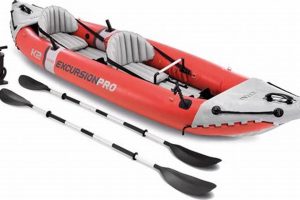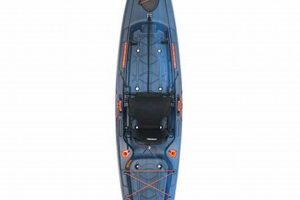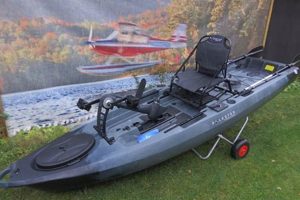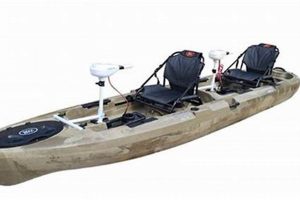Kayak fishing involves the use of a kayak to access fishing locations and engage in the sport of angling. It offers anglers a unique way to explore various bodies of water, from calm lakes and rivers to coastal waters and oceans, often reaching areas inaccessible by larger vessels. For example, a kayak allows an angler to navigate shallow creeks, maneuver through dense vegetation, and approach fish quietly, enhancing the chances of a successful catch.
This method provides numerous advantages including increased stealth and maneuverability, allowing for a closer approach to fish, particularly in shallow or heavily vegetated areas. This proximity often translates to a higher catch rate and a more immersive experience in nature. Furthermore, the low cost and relative simplicity of kayak fishing compared to motorized boating make it an accessible and appealing activity for a wide range of anglers. Historically, kayaks have been used for fishing and hunting for centuries by indigenous cultures around the world, demonstrating their long-standing effectiveness and adaptability.
Successfully adapting angling techniques to the kayak platform requires addressing several key aspects: choosing the right kayak and equipment, mastering essential paddling and maneuvering techniques, understanding safety procedures, and employing effective fishing strategies for different environments. These topics will be explored in greater detail in the sections that follow.
Tips for Kayak Fishing
Effective kayak fishing requires careful planning and execution. The following tips offer guidance for a safe and productive experience.
Tip 1: Choose the Right Kayak: Kayak selection depends on the intended fishing environment. Longer kayaks track better in open water, while shorter, wider kayaks offer greater stability in calmer environments. Sit-on-top kayaks are generally preferred for fishing due to their self-bailing design and ease of re-entry after a capsize.
Tip 2: Prioritize Safety Equipment: Always wear a personal flotation device (PFD). Carry a whistle, signaling mirror, and a waterproof communication device for emergencies. A first-aid kit and basic repair kit are also recommended.
Tip 3: Plan Your Trip: Check weather forecasts and water conditions before embarking on any kayak fishing trip. Inform someone of your planned route and expected return time. Pack plenty of water and sunscreen.
Tip 4: Master Basic Paddling Techniques: Efficient paddling conserves energy and allows for greater control of the kayak. Practice different strokes to navigate effectively in various conditions, including wind and currents.
Tip 5: Organize Your Gear: Utilize rod holders, tackle boxes, and other storage solutions to keep fishing gear organized and accessible. This minimizes clutter and allows anglers to focus on fishing.
Tip 6: Employ Appropriate Anchoring Techniques: A properly set anchor prevents drifting and maintains position in desired fishing locations. Anchor trolleys offer additional control and flexibility when fishing in current.
Tip 7: Practice Catch and Release Techniques: Proper handling and release practices minimize stress on fish and contribute to healthy fish populations. Use appropriate hooks and tools, and handle fish gently.
By adhering to these guidelines, anglers can enhance their safety, improve their efficiency, and maximize their enjoyment on the water. Proper preparation contributes significantly to a successful and rewarding kayak fishing experience.
These tips provide a foundational understanding of essential elements for kayak fishing. Further exploration of specific techniques and equipment can enhance proficiency and enjoyment of this unique angling approach.
1. Planning and Preparation
Thorough planning and preparation are fundamental to successful and safe kayak fishing excursions. These preliminary steps directly influence the overall outcome and experience. Neglecting this crucial phase can lead to various complications, from equipment malfunctions and inadequate safety measures to missed fishing opportunities and potential hazards. For instance, failing to check weather conditions could result in encountering unexpected storms or strong winds, compromising safety and hindering fishing efforts. Similarly, inadequate packing might leave anglers without essential gear like spare fishing line or a first-aid kit, potentially turning a minor inconvenience into a significant problem.
Effective planning involves several key aspects. Researching potential fishing locations beforehand allows anglers to identify suitable areas based on target species, water conditions, and accessibility. Checking weather forecasts is paramount for safety and helps determine optimal fishing times and appropriate clothing. Creating a float plan and sharing it with a trusted contact ensures someone is aware of the planned route and expected return time, a vital safety precaution. Packing essential equipment, including safety gear, fishing tackle, and appropriate clothing, is crucial for preparedness. For example, packing a dry bag with extra clothing, food, and water can be essential in case of unexpected delays or changes in weather.
In conclusion, meticulous planning and preparation constitute a critical component of successful kayak fishing. These proactive measures mitigate potential risks, enhance efficiency on the water, and contribute significantly to a positive and rewarding experience. By prioritizing these initial steps, anglers can focus on enjoying the sport and maximizing their chances of a successful catch while ensuring their safety and well-being.
2. Essential Equipment
Appropriate equipment is crucial for successful and safe kayak fishing. Selection and utilization of gear directly impacts angling effectiveness and overall experience. Understanding the function and purpose of essential equipment allows for informed choices tailored to specific fishing environments and target species. This section details critical gear components, offering insights into their practical application and importance within the context of kayak fishing.
- Personal Flotation Device (PFD)
A PFD is a non-negotiable safety item. It provides buoyancy and is essential for survival in the event of capsize or accidental immersion. Selecting a comfortable, well-fitting PFD designed for paddling enhances both safety and mobility on the kayak. For instance, a PFD with high visibility features improves visibility in low-light conditions or open water, a crucial safety consideration.
- Paddle
The paddle propels and maneuvers the kayak, enabling access to fishing locations and controlled positioning. Paddle length and blade shape influence paddling efficiency and comfort. A paddle leash prevents loss in the event of a dropped paddle. For example, a paddle with a feathered blade design can reduce wind resistance and improve paddling efficiency, especially in windy conditions.
- Rods and Reels
Rod and reel selection depends on target species and fishing techniques. Shorter rods are often preferable in a kayak environment due to space constraints. Rod holders mounted on the kayak provide secure storage and easy access. For instance, a medium-action spinning rod and reel combination offers versatility for various freshwater species and techniques.
- Tackle and Accessories
Essential tackle includes hooks, line, lures, and bait appropriate for target species. A tackle box or bag keeps gear organized and accessible. Other helpful accessories include a landing net, pliers, and a knife. For example, carrying a selection of lures in various sizes and colors allows anglers to adapt to changing fish behavior and water conditions.
The proper selection and utilization of essential equipment contributes significantly to a safe and productive kayak fishing experience. Understanding the function and purpose of each piece of gear allows anglers to make informed decisions that enhance their efficiency on the water. These choices ultimately contribute to a more rewarding and enjoyable angling experience from both a practical and safety standpoint.
3. Kayak Control
Effective kayak control is fundamental to successful fishing from a kayak. Mastery of maneuvering techniques allows anglers to position themselves strategically, maintain stability, and present lures or bait effectively. Precise boat control enhances fishing efficiency and contributes significantly to a safe and productive experience on the water. This section explores essential facets of kayak control and their direct impact on the ability to fish effectively from a kayak.
- Paddling Techniques
Efficient paddling techniques are essential for navigating to desired fishing locations and maintaining position against wind and current. Forward strokes, reverse strokes, and sweep strokes provide directional control, while draw strokes facilitate lateral movement. Understanding and practicing these techniques enables anglers to maneuver precisely and efficiently, maximizing fishing opportunities. For instance, using a draw stroke allows an angler to position the kayak closer to submerged structure or vegetation where fish might be holding.
- Positioning and Stability
Maintaining stability while fishing from a kayak is crucial for casting accuracy and safe handling of fish. Understanding the kayak’s center of gravity and weight distribution influences stability. Proper posture and controlled movements minimize rocking and enhance balance. For example, leaning too far to one side while casting can destabilize the kayak, potentially leading to a capsize.
- Anchor Systems
Anchor systems provide stationary positioning, crucial for fishing specific locations or holding position in current. Different anchor types and deployment methods cater to various water depths and bottom compositions. An anchor trolley system allows for controlled anchor positioning along the kayak’s length, enhancing fishing versatility. For example, deploying a drift sock or stake-out pole in shallow water allows an angler to fish a specific area effectively without disturbing the bottom.
- Wind and Current Management
Wind and current exert significant influence on kayak movement and require appropriate maneuvering techniques. Understanding how wind and current affect kayak position enables anglers to adjust paddling and positioning strategies accordingly. Using a rudder or skeg can assist with tracking and directional control in windy conditions. For instance, paddling into the wind or current requires more effort and different paddle strokes compared to paddling with them.
Proficient kayak control enhances angling effectiveness and overall enjoyment of the sport. By mastering these techniques, anglers can focus on fishing rather than constantly battling to maintain position or navigate effectively. Improved kayak control contributes directly to a safer, more efficient, and ultimately more rewarding fishing experience from a kayak.
4. Fishing Techniques
Adapting fishing techniques to the kayak platform is crucial for maximizing success and enjoyment. The confined space and unique mobility of a kayak require modifications to traditional angling methods. Understanding these adaptations allows anglers to effectively present lures or bait, manage fish, and maintain stability, crucial elements for a productive and enjoyable experience.
- Casting Techniques
Casting from a seated position in a kayak requires adjustments to body mechanics and casting angles. Shorter rods and underhand or sidearm casts are often employed to avoid interference with the kayak’s structure or low-hanging branches. Practicing these modified casting techniques enhances accuracy and prevents snags, optimizing presentation in the kayak’s limited space. For example, a sidearm cast allows for precise lure placement under overhanging vegetation.
- Line Management
Effective line management prevents tangles and facilitates efficient hooksets in the confined space of a kayak. Keeping excess line controlled and using appropriate line retrieval techniques minimizes complications during retrieves and fights. This is especially important when fishing in areas with submerged obstacles or strong currents. For example, using a line stripping basket keeps retrieved line organized and prevents tangles.
- Fighting and Landing Fish
Fighting and landing fish from a kayak present unique challenges and require specific techniques. Maintaining balance and leverage while playing a fish is crucial. Using a landing net and appropriate fish handling tools aids in secure retrieval and minimizes stress on the fish. For example, keeping a low center of gravity and using the kayak’s paddle for support enhances stability during a fight.
- Trolling from a Kayak
Trolling from a kayak offers a unique way to cover water and target specific species. Utilizing rod holders and adjusting trolling speed allows for effective lure presentation. Monitoring line and rod action is crucial for detecting strikes. For example, trolling with a diving lure or a downrigger can target fish at specific depths.
Adapting these fishing techniques to the kayak environment significantly enhances angling effectiveness and safety. These modifications allow anglers to leverage the unique advantages of kayak fishing, improving presentation, maximizing catch potential, and ultimately contributing to a more rewarding experience on the water. Understanding and practicing these techniques is essential for any angler seeking to maximize their success and enjoyment while fishing from a kayak.
5. Safety Procedures
Safety procedures are paramount in kayak fishing. The inherent risks associated with on-water activities necessitate a proactive approach to risk mitigation. Understanding and implementing appropriate safety measures significantly reduces the likelihood of accidents and ensures a more secure and enjoyable experience. Neglecting safety protocols can lead to serious consequences, impacting not only personal well-being but also potentially creating hazardous situations for others on the water. This section explores essential safety procedures integral to responsible kayak fishing.
- Pre-Trip Planning
Thorough pre-trip planning forms the foundation of safe kayak fishing. Checking weather forecasts and water conditions is crucial for anticipating potential hazards and making informed decisions about launch locations and trip duration. Informing someone of the planned route and estimated return time provides an additional layer of security. For example, consulting a local tide chart or river flow report can help avoid unexpected changes in water levels or currents. A filed float plan provides crucial information to rescue personnel in case of an emergency.
- Personal Flotation Devices (PFDs)
Wearing a properly fitted PFD is non-negotiable. PFDs provide essential buoyancy in the event of capsize or accidental immersion, significantly increasing chances of survival. Choosing a PFD designed for paddling comfort and mobility enhances both safety and overall enjoyment on the water. For example, inflatable PFDs offer greater freedom of movement while still providing vital flotation when activated.
- Navigation and Communication
Carrying essential navigation and communication tools is crucial for maintaining situational awareness and summoning assistance if needed. A waterproof GPS device or chart and compass provide accurate positioning information, while a VHF radio or a charged mobile phone in a waterproof case enables communication in emergencies. Carrying a whistle or signaling mirror offers additional means of attracting attention. For example, a handheld GPS can be used to mark waypoints, track progress, and navigate back to the launch point, particularly in unfamiliar waters or low visibility conditions.
- Cold Water Safety
Cold water presents significant risks to kayakers. Hypothermia can occur rapidly in cold water environments, even in relatively mild air temperatures. Dressing appropriately for water temperature, not just air temperature, is essential. Wearing a wetsuit or drysuit provides insulation and protection in cold water conditions. Understanding the symptoms of hypothermia and appropriate first-aid responses is crucial for mitigating potential risks. For example, carrying a spare set of dry clothes in a waterproof bag can be vital in preventing hypothermia after an unexpected immersion in cold water.
Adhering to these safety procedures is integral to responsible kayak fishing. These preventative measures mitigate risks, enhancing both personal safety and the overall enjoyment of the sport. By prioritizing safety, anglers contribute to a more secure and responsible on-water experience for themselves and others, allowing for a greater focus on the enjoyment of fishing and the natural environment.
6. Respectful Practices
Respectful practices are integral to the sustainability of kayak fishing and the preservation of aquatic ecosystems. These practices extend beyond mere adherence to regulations and encompass a deeper understanding of the delicate balance within these environments. The act of fishing from a kayak places anglers in close proximity to nature, demanding a heightened awareness of their impact. Cause and effect relationships are readily apparent; discarded fishing line entangles wildlife, improper fish handling reduces survival rates, and excessive noise disturbs natural habitats. For instance, carelessly discarding plastic bait containers contributes to pollution and poses a threat to aquatic life. Respectful practices are not merely a component of how to fish on a kayak; they are a fundamental requirement for responsible engagement in the sport.
Practical application of respectful practices involves mindful actions throughout the fishing experience. Proper catch-and-release techniques minimize stress on fish, increasing post-release survival rates. Carrying a reusable trash bag and retrieving any discarded fishing line, even if it’s not one’s own, demonstrates a commitment to environmental stewardship. Minimizing noise pollution through quiet paddling and conversation contributes to the preservation of natural tranquility. Respecting private property and adhering to access restrictions further demonstrate responsible behavior. For example, using barbless hooks or crushing barbs on existing hooks facilitates easier hook removal and minimizes injury to fish during catch and release.
In conclusion, respectful practices represent a crucial aspect of sustainable kayak fishing. Understanding the interconnectedness of angler actions and environmental consequences reinforces the importance of these practices. Challenges remain in promoting widespread adoption of these principles, but the practical significance is undeniable. By embracing respectful practices, anglers contribute directly to the long-term health of aquatic ecosystems, ensuring the future of the sport and preserving the natural beauty that draws people to kayak fishing in the first place. This commitment fosters a more sustainable and harmonious relationship between anglers and the environment they cherish.
Frequently Asked Questions
This section addresses common inquiries regarding kayak fishing, offering concise and informative responses to clarify potential uncertainties and provide practical guidance for anglers.
Question 1: What type of kayak is best suited for fishing?
Kayak selection depends on individual needs and the intended fishing environment. Sit-on-top kayaks are generally preferred for their stability and self-bailing design. Longer kayaks offer better tracking in open water, while shorter, wider kayaks provide enhanced stability in calmer environments. Specialized fishing kayaks often feature built-in rod holders, storage compartments, and other angler-specific features.
Question 2: What essential safety equipment is required for kayak fishing?
A personal flotation device (PFD) is paramount. A whistle, signaling mirror, and a waterproof communication device are crucial for emergencies. A first-aid kit and basic repair kit should also be carried. Navigation tools, such as a GPS or compass, and appropriate lighting are essential for trips in low-light conditions or unfamiliar waters.
Question 3: How does one manage fishing gear effectively in a kayak?
Organization is key. Utilizing rod holders, tackle boxes, and specialized kayak storage solutions keeps gear accessible and prevents clutter. Dry bags protect essential items from water damage. Minimizing gear reduces weight and enhances stability. A well-organized kayak allows anglers to focus on fishing rather than managing equipment.
Question 4: What are effective anchoring techniques for kayak fishing?
Anchor selection and deployment depend on water depth and bottom composition. Traditional anchors, stake-out poles, and drift socks offer various anchoring solutions. An anchor trolley system allows for adjustable anchor positioning. Understanding appropriate anchoring techniques for specific environments is essential for maintaining desired fishing locations.
Question 5: How does wind or current affect kayak fishing, and how can one adapt?
Wind and current influence kayak positioning and require adaptive paddling techniques. Paddling into the wind or current requires more effort and different paddle strokes. Drift socks or sea anchors can be used to control drift speed. Understanding how wind and current affect the kayak enables anglers to adjust strategies and maintain desired positions.
Question 6: What are recommended practices for catch and release in kayak fishing?
Minimizing handling time and using appropriate tools, such as dehookers and pliers, reduces stress on fish. Supporting the fish horizontally minimizes strain. Reviving the fish in the water before release ensures its ability to recover and swim away. Proper catch-and-release techniques promote healthy fish populations and sustainable fishing practices.
Understanding these fundamental aspects of kayak fishing allows for a safer, more efficient, and rewarding experience on the water. Further research and practice enhance proficiency and contribute to responsible engagement in the sport.
This concludes the frequently asked questions section. The following sections will delve deeper into specific techniques and provide advanced tips for maximizing success in kayak fishing.
Conclusion
This exploration of kayak fishing has provided a comprehensive overview of essential aspects, from equipment selection and safety procedures to specialized techniques and respectful practices. Emphasis has been placed on the interconnectedness of these elements, highlighting how proper preparation, informed decision-making, and responsible angling contribute to a successful and sustainable experience. Key takeaways include the importance of selecting appropriate gear, mastering kayak control techniques, adapting fishing strategies to the kayak platform, and prioritizing safety at all times. Furthermore, the ethical dimensions of kayak fishing have been underscored, emphasizing the angler’s role in preserving aquatic ecosystems through mindful practices.
Kayak fishing offers a unique and rewarding way to connect with nature and engage in the sport of angling. The accessibility and adaptability of this approach continue to attract a growing number of enthusiasts seeking immersive outdoor experiences. As kayak fishing gains popularity, continued emphasis on responsible practices and environmental stewardship will be crucial for ensuring the long-term health and sustainability of this evolving pursuit. The future of kayak fishing rests on the collective commitment of anglers to embrace ethical principles and prioritize the preservation of aquatic environments for generations to come.






